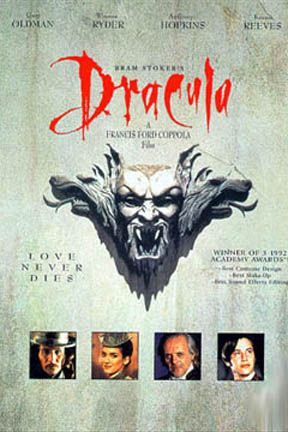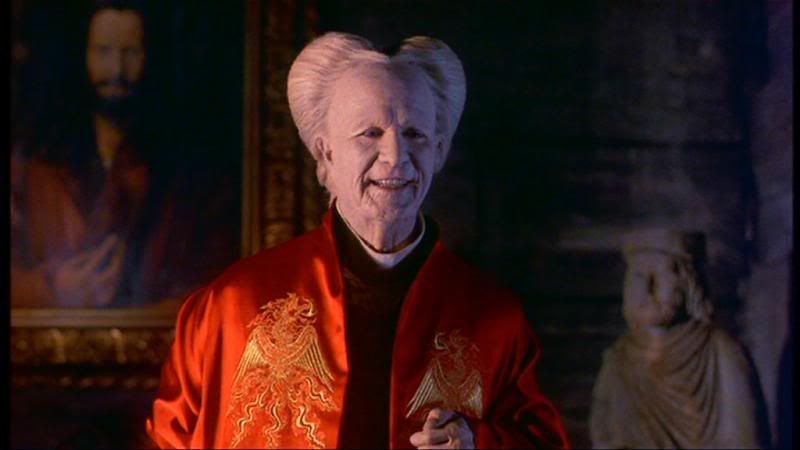It may be hard to realize for some young folks these days, but vampires didn’t always sparkle. Nor did they collectively get obsessed with a particular young woman who happens to have really tasty blood or a particular smell. The roots of the vampire tale go deep, and one of the earliest tales to reach a mass market was a novel by Bram Stoker. It’s served as the core for a lot of stories since its publication in 1897, and my favorite adaptation thus far is the 1992 film helmed by legendary director Francis Ford Coppola, concretely entitled Bram Stoker’s Dracula.

The year is, in fact, 1897, and solicitor Jonathan Harker is being entrusted with the job of a lifetime. His colleague, a man named Renfield, has gotten locked away in bedlam, and it falls to Harker to do the last bit of paperwork to secure the real estate acquisitions of an influential but eccentic Romanian businessman. Harker says good-bye to his fiancee Mina and heads to Transylvania to meet his client, the reclusive Count Dracula. Dracula welcomes Harker with warmth and hospitality, but when he sees a photograph of Mina among Harker’s effects, he suddenly becomes… something else. When Dracula goes to England to claim what’s his, he not only draws Mina and her circle of friends into his perilous life, he attracts the attention of one Abraham Van Helsing.
Before I get into the characters, which are the true pulsing heart and hot blood of Dracula, I want to talk about how Coppola put this movie together. The first word that springs to mind when I consider the film is “sumptuous.” While some more modern tales opt for a washed-out aesthetic, colors have a tendency to pop off of the screen and elements like shadow and camera movement are used excellently. Some portions of the set design and establishing shots feel informed by an earlier era of creature features, and the film boldly shuns most modern special effects techniques, adding even more to the feeling of cinematic nostalgia. Monstrosity and the powers of the night are achieved through Oscar-winning makeup, sound editing and costume design, brought to life by a mostly excellent cast.

“Come in, come in. Stay a while. Have a drink.”
I maintain that Gary Oldman is one of the best and perhaps most underrated actors of his generation. He has an impressive range and natural charisma that informs just about any role he adopts. His Dracula makes full use of both of these aspects, as he goes through many fascinating and sometimes disturbing changes over the course of the film. He is the magnetic center around which the rest of the film revolves, and his work here is truly impressive. Anthony Hopkins is no slouch, either, and counters Dracula’s outright alien nature with a very human and determined Van Helsing. The stiff and somewhat staid performances of Keanu Reeves and Winona Ryder as Harker and Mina can be off-putting at first – in fact, Reeves is often called out for “ruining” the movie – but what I like about these initially wooden portrayals is that they show us the sort of people to whom Dracula was introduced by Bram Stoker over a century ago.
In Victorian times, the roles of men and women in terms of sex and sexuality were extremely strict and defined. Not everyone subscribed to this, but the common thinking was that men were almost constantly poised to take advantage of the women around them, and women thus subjected to such lusts would essentially transform from ladies of innocense and purity to insatiable, wanton women. Thus sex contained an element of fear and terror, something against the enlightened individual must always be on guard, and Stoker’s novel takes that juxtaposition to a natural conclusion, personifying these elements in the vampire. Bram Stoker’s Dracula preserves this in that the film’s luscious visuals and content often walk a fine line between the erotic and the macabre. The effect is, not unlike the character himself, hypnotic and seductive, drawing us into a world that feels ancient yet familiar, and refusing to let us go.

It’s amazing what a jaunt outside of the castle can do for you.
Bram Stoker’s Dracula does have some flaws, including a couple missteps in pacing and storylines that can make the plot feel a touch crowded, but its energy and presentation balance these elements out and the casting and direction push the film into an even more positive category. Dracula as a character can be difficult for an audience to sympathize with, but Oldman’s performance demonstrates how to pull off such a feat. The film, like the character, is a noble and passionate if somewhat cursed and depraved relic of yesteryear, and is all the more charming and seductive in an age of sterile CG and lifeless characters, to say nothing of some of the pretenders to Dracula’s throne. He is the unquestionable and ultimate lord of darkness, and Coppola’s vision of his story remains one of the finest vampire movies ever made.


